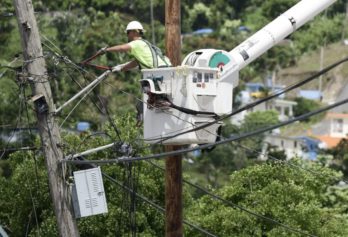
Donald Trump(AP Photo/Evan Vucci)
WASHINGTON (AP) — President Donald Trump will come face to face with Puerto Ricans struggling to recover from Hurricane Maria on Tuesday, amid criticism that the federal government’s response has been sluggish. Pushing back, Trump has faulted local officials as “politically motivated ingrates.”
The president is expected to spend more than five hours on the ground, meeting with first responders, local officials and some of the 3.4 million people whose lives have been upended by a hurricane that, in the president’s words, left the island U.S. territory “flattened.”
“There’s nothing left. It’s been wiped out,” Trump said last week. “Nobody has ever seen anything like it.”
The trip will be Trump’s fourth to a region battered by storms during an unusually violent hurricane season that has also seen parts of Texas, Florida, Louisiana and the U.S. Virgin Islands inundated by floodwaters and whipped by winds.
It comes nearly two weeks after the storm and after a weekend in which Trump aggressively pushed back against critics, including San Juan Mayor Carmen Yulin Cruz. Trump responded angrily, deriding the “poor leadership ability by the Mayor of San Juan, and others in Puerto Rico, who are not able to get their workers to help” on Twitter.
“They want everything to be done for them when it should be a community effort,” he added, scoffing at “politically motivated ingrates” who had criticized the effort, and insisting that “tremendous progress” was being made.
Cruz has had accused the administration of “killing us with the inefficiency” and begged the president to “make sure somebody is in charge that is up to the task of saving lives.”
Sanders said Cruz had been invited to participate in Tuesday’s events, but it was unclear whether she and the president would meet.
Trump and first lady Melania Trump are scheduled to attend briefings and meet with Gov. Ricardo Rosselló, as well as the governor of the U.S. Virgin Islands. They’ll also meet with Navy and Marine Corps personnel on the flight Deck of the USS Kearsarge.
Even before the storm hit on Sept. 20, Puerto Rico was in dire condition thanks to a decade-long economic recession that had left its infrastructure, including the island’s power lines, in a sorry state. Maria was the most powerful hurricane to hit the island in nearly a century and unleashed floods and mudslides that knocked out the island’s entire electrical grid and telecommunications, along with many roads.
Nearly two weeks later, 95 percent of electricity customers remain without power, including some hospitals. And much of the countryside is still struggling to access basic necessities, including food, fresh water and cash.
Trump and other administration officials have worked in recent days to reassure Americans that recovery efforts are going well and combat the perception that the president failed to fully grasp the magnitude of the storm’s destruction in its immediate aftermath.
White House Press Secretary Sarah Huckabee Sanders said Monday the trip would focus on local recovery efforts, “which we’re fully committed to.”
“The top priority for the federal government is certainly to protect the lives and the safety of those in affected areas and provide life-sustaining services as we work together to rebuild their lives,” she said.
While early response efforts were hampered by logistical challenges, officials say that conditions, especially in the capital, have improved.
According to the Federal Emergency Management Agency, there are now more than 10,000 federal officials on the ground on the island, and forty-five percent of customers now have access to drinking water. Businesses are also beginning to re-open, with 60 percent of retail gas stations now up and running.
For many, however, that isn’t enough. On Monday, the nonprofit Oxfam announced that it would be taking the rare step of intervening in an American disaster, citing its outrage over what it called a “slow and inadequate response.”
___


